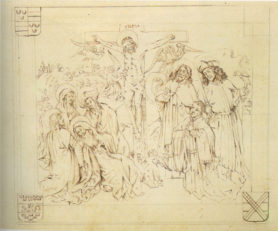3.2 Criteria for the inclusion of objects
Point of departure
Included in the MeMO database are descriptions of tomb monuments, floor slabs and memorial pieces that have survived (at least partially) and that originate from the medieval institutions located in the area that is currently the Netherlands. Note that a number of the objects in the database cannot be properly placed, because the institutions in which they originally functioned are unknown.
MeMO covers the period until 1580, the approximate date when, due to the Reformation, Catholicism was (temporarily) abolished as the official religion in large parts of the area that is now the Netherlands. Tomb monuments, floor slabs and memorial pieces could be placed either long before or long after the death of one or more of the individuals who were commemorated on the object. This is why a justification for the date of each object is provided. A date of death is just an indication for further research.
Included:
- Objects that have been at least partially preserved, MeMO memorial object ID 3527, fragments of a brass
- Objects of which there exist photographs and modern descriptions but whose current location is unknown, MeMO memorial object ID 579, and some objects that have been lost but of which there are photographic records. (Descriptions of the latter can be found using Search database, under Category: Type: Memorial item, only surviving as a printed image, drawing or photo)
- Objects whose precise date is unknown, but which are believed on stylistic grounds to date from before or around 1580, MeMO memorial object ID 210
- Copies of objects, if they also had (or may have had) a function in the commemoration of the dead, MeMO memorial object ID 687
- Objects which were produced by artists and stone masons working in the Netherlands, but for which the original location in which they functioned has not (yet) been ascertained. In these cases the possibility of a memorial function of these objects in the area under consideration is presumed
- Objects produced by artists and stone masons working outside the Netherlands, but for which a memorial function in the area under consideration before 1580 is certain or presumed, MeMO memorial object ID 921
- Objects that originally had a memorial function abroad but subsequently functioned as such in the Netherlands, MeMO memorial object ID 3255
- Pieces (whether or not containing devotional portraits) that were not initially produced for the commemoration of deceased persons. They may for instance have been created for a wedding, see MeMO memorial object ID 626. It has been ascertained from archival records that existing works of art could be altered into memorial pieces.
Not included:

Fig. 7. Drawing of a lost Crucifixion with the devotional portrait of Dirk van Wassenaar. This provost and archdeacon of the Utrecht Janskerk was also parish priest of the Haarlem St. Bavokerk; its patron saint is depicted behind the kneeling figure of Dirk
- Objects commemorating Dutch persons that were placed abroad
- Objects that are mentioned in documents, but which are not otherwise known to us
- Objects that are known through drawings in genealogical and heraldic manuscripts, but that probably have been lost, see fig. 7
- Artworks to which a devotional portrait or memorial text was added after 1580 and which served a memorial function from that moment onwards. Please note: these are objects that fulfilled a different function before 1580. Objects have been included however that were produced and placed during one’s lifetime and to which the date of death was added after 1580. After all, these were intended before 1580 to fulfill commemorative purposes.
It is quite possible that floor slabs, tomb monuments and memorial pieces in private collections and in depots of archaeological agencies and museums have never been catalogued nor published.

